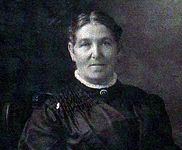Name Maud Grieve | ||
 | ||
Died 1941, Barkway, United Kingdom Books A Modern Herbal: The Medicinal, Culinary, Cosmetic and Economic Properties, Cultivation and Folk-lore of Herbs, Grasses, Fungi, Shrubs & Trees with All Their Modern Scientific Uses | ||
Sophie Emma Magdalene Grieve (nee Law) known as Maud. Born 4 May 1858 75 Upper Street, Islington, London. Died 21 December 1941 Royston, Hertfordshire. Herbalist, plants women, writer.
Contents
Lived in Chalfont St Peter, Bucks, from 1906 to 1938 where she created a perennial nursery. At the outbreak of the First World War she turned the nursery into a herb farm to address the shortage of supplies of vital medicinal plants. She was a founder member of the short lived National Herb Growing Association (1914-17) and later president of The British Guild of Herb Growers (est. 1918.) During the war she also started The Whins Medicinal and Commercial Herb School. After the war she continued her work promoting the benefits of herbs, writing over three hundred pamphlets or monographs on individual plants. These were edited by Hilda Leyel and were the main source of information in what has become Maud’s legacy A Modern Herbal which was published 1931.
Background
Maud’s father died in 1864 and she grew up in the care of relatives in Beckenham, London, where she received a good education. Following the death of her uncle in 1879, she was left an inheritance of a £1000. There is no record of her whereabouts or activities during the following four years, however by 1883 she had travelled to India where she met and married William Grieve (1846-1929) originally from Edinburgh. He was manager of the Bally Paper Mill near Calcutta from 1878 to 1894 when the couple returned to England. They lived in a number of places including Hayes, Middx and Chartridge, near Chesham, Bucks before moving to the house that William had designed at Chalfont Common, Chalfont St Peter. They named it The Whins after the yellow gorse that grew in the neighbourhood. Maud created an extensive perennial garden on the one and half acre plot.
Work during WWI
Maud was keen to be involved in the war effort and around this time turned her garden over completely to herb cultivation and started her life’s work the writing of her monographs. She spent long days in the garden and then worked into the night on her research, writing up the information and also on her correspondence, she was a prolific letter writer all her life (some of her letters are held in the Kew Herbarium library and others are in a private collection). In October 1914 the Board of Agriculture published Bulletin no. 288, The Cultivation & Collection of Medicinal plants in England to deal with the inadequate supplies, the shortage was due to the fact that most of the plants used in the pharmaceutical industry had been imported cheaply prior to the start of the war and the ports were closed to the European market. The drugs required were: henbane, foxgloves, deadly nightshade and monkshood. The National Herb Growing Association was set up by a group of educated women under the auspices of the Women’s Farm & Garden Union. The association had the backing of members of the Pharmaceutical Society, including Edward Morrell Homes (1843-1930) who was appointed as the government advisor.
.
